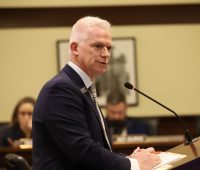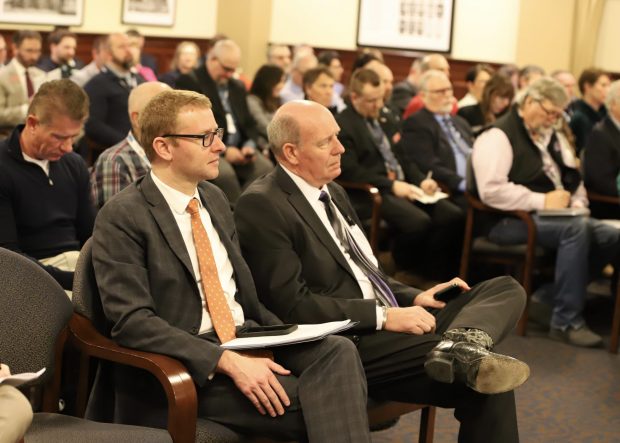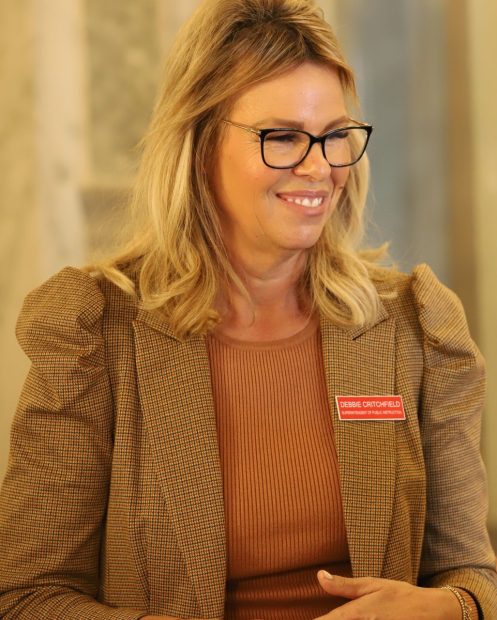A new state plan to spend $2 billion on school facilities is a step toward alleviating districts’ reliance on local property taxes, but it won’t solve the problem, school leaders told lawmakers Tuesday.
School trustees and administrators packed the House Revenue and Taxation Committee’s meeting as the panel nearly unanimously endorsed House Bill 521. The bill would direct $200 million annually to public schools and cut income taxes.
It’s the “first real attempt” the state has made to address the fact that “facilities cost a lot of money,” said Andy Grover, executive director of the Idaho Association of School Administrators and a former Melba School District superintendent.

“While this will help reduce bonds, levies and plant facilities, it doesn’t get rid of them.”
Gov. Brad Little’s office and House Republican leadership crafted the plan, which House Speaker Mike Moyle, R-Star, called a “compromise bill.” House Majority Leader Jason Monks emphasized Tuesday that HB 521 is, “first and foremost,” a tax cut. It will trim income tax rates for individuals and corporations from 5.8% to 5.695%. And the ultimate goal in helping schools fund facilities is to eliminate the need for bonds and levies, said Monks, R-Meridian.
In 2022, taxpayers shelled out a record $596 million for bonds and levies. That total has gone down after lawmakers last year gave schools about $106 million to pay down bonds and levies through House Bill 292, another far-reaching property tax relief bill.
Still, recent estimates have put school construction needs at roughly $1 billion. Little last month floated a $2 billion plan — $1.5 billion of which is new spending — to address Idaho’s “crumbling, leaking, falling apart” school buildings.
“We’re deeply grateful to the governor and legislative partners in coming up with this exciting proposal,” said Jason Knopp, a school board chairman from Melba. But Knopp added that he wanted to “temper expectations.”
“It simply will not exclude the reality that most districts will still have to go to their taxpayers to build new schools,” Knopp said. “It costs $25 to $30 million to build an elementary school whether you live in Boise, Bancroft or Bonners Ferry.”
The new money would also come at a cost to school districts. They’ll have to forfeit a bond and levy election date for the second legislative session in a row — this year’s bill would eliminate the August election, after lawmakers nixed the March election last year.
Districts would also have to abide by new restrictions on four-day school weeks. The bill directs the State Board of Education to set minimum contract and instructional days for four-day districts. The shorter weeks have allowed many small districts to cut costs and recruit and retain teachers, school leaders said. Some administrators are worried they’ll have to pay for additional teaching days without added funding to match salary and operational costs, Grover said.
“We have a lot of questions,” he said.

The HB 521 funds would have to be spent on school maintenance and construction, meaning districts wouldn’t have the discretion to use it for teacher salaries or other expenses. To be eligible for the money, districts will have to submit a 10-year facilities plan to the state. And they must comply with the state’s anti-critical race theory law and agree that their job applicants won’t have to sign “written diversity statements.”
Rep. Ned Burns, D-Bellevue, asked Monks why “it was important” to include the diversity statement provision in a school funding bill. Monks responded that it’s not unlike many appropriations bills that have dealt with diversity, equity, inclusion and critical race theory.
“If you’re going to be spending the money that the state provides, then here’s the criteria that you’re going to have surrounding that particular subject matter,” he said.
It remains unclear how much money each school district would get if the bill passes. Districts could take their share all at once or in increments over a decade. The funds would be distributed based on average daily attendance, meaning large districts would get the largest share.
Bill sponsors have guarded a spreadsheet that shows district-by-district estimates. When House Assistant Minority Leader Lauren Necochea asked Monks to share the numbers, Monks said he didn’t have copies of the most up-to-date spreadsheet but would share it with committee members later.
Necochea, D-Boise, was the only committee member to oppose the bill. She said a version of a spreadsheet that “potentially has errors” showed “a lot of inequity” in how the funds would be divided. The West Ada School District could get three times more than the Boise School District, Necochea said.
The bill has a provision capping at $40 million the amount a few Idaho districts — including Boise — can receive. The cap applies to districts established prior to statehood that don’t need voter approval for certain tax increases.
School trustees and administrators are anxiously waiting to see how the bill would affect their finances. After a fire badly damaged a high school in the Pocatello-Chubbuck School District, leaders last week said they’re holding off on formalizing another bond measure until they know how much they’ll get.
The bill now heads to the House. Dozens of House members already have signed on to co-sponsor the bill, which means it’s almost certain to pass. Revenue and Taxation Committee Republicans lauded the bill Tuesday.
“I think this moves us towards our constitutional responsibility” to fund public schools, said Rep. Kenny Wroten, R-Nampa. “I think we’re doing a lot of good things here.”
Two trustees’ perspectives on the facilities bill
While Rev and Tax discussed the far-reaching facilities bill in a meeting room on one end of the Statehouse, school trustees crowded into a meeting room at the other end of the building, for their annual lobbying trip to the Capitol.
Two trustees offered differing views of House Bill 521.
“We’re all for this facilities bill,” said Eric Smallwood, chair of the Twin Falls district’s board of trustees.
Twin Falls stands to receive $35 million from HB 521, which would offset much of its $60 million facilities backlog. The money would help Twin Falls replace roofs and HVAC systems — replacing aging boilers and rotting swamp coolers in buildings dating back to 1938.
Boundary County trustee Teresa Rae was noncommittal. Her district needs to replace Valley View Elementary School, which was built in 1949 and does not meet current building codes. A replacement school could cost close to $20 million — and in 2022, Boundary County voters rejected a pair of bond issues.
Boundary County received $515,000 from House Bill 292, a property tax relief law passed in 2023. But with no bond on the books, Boundary County could only use its money to pay down an existing school levy. With that in mind, Rae isn’t sure the new bill would help offset bond costs.
“We are waiting to see what HB 521 actually does for us.”
Critchfield pitches short-term, long-term funding fixes
State superintendent Debbie Critchfield repeated her pitch for a one-time $161.7 million school funding pitch — and pledged to come back with a long-term proposal.

Speaking to the House Education Committee Tuesday morning, Critchfield said the Legislature will need to pass a bill to fully fund K-12 this school year. “Unless something changes, it will not go out.”
The $161.7 million gap reflects money the 2023 Legislature appropriated for schools. But at the same time, the 2023 Legislature also shifted back to a funding model based on student attendance. If the state had kept its pandemic-era enrollment-based formula intact, this $161.7 million would have gone out to the schools.
There is no “political will” to use a enrollment-based formula permanently, said Critchfield, so she is proposing two ways to work around the impasse.
First, Critchfield is proposing a $161.7 million supplemental budget for the current school year.
Second, Critchfield said she is working on a permanent fix that would fill the gap in future years. It would take the discretionary dollars the state gives the schools, $329 million a year, and provide extra funding for special education students, English language learners and disadvantaged students. Schools with higher at-risk student populations would receive a larger share of this money.
”There are some students that cost more money,” Critchfield told the committee. “This is not us trying to game something. We want to pay for the students people have.”
Critchfield said she will bring this long-term bill to House Education later this session.
House OKs reading indicator exemption
The House overwhelmingly approved a bill to exempt some English language learners from the state’s reading test.
Students who have spent less than two years in a school in the United States and who score low on the state’s English language proficiency test would be exempt from the Idaho Reading Indicator (IRI).
Currently, IRI test scores include “false negatives,” said bill sponsor Rep. Soñia Galaviz, D-Boise. “It’s saying kids are failing, which they are (on) that particular exam, but it’s because they don’t have the English in order to access the test in the first place.”
The House approved the bill by a 57-12 vote. A dozen Republicans opposed it.
